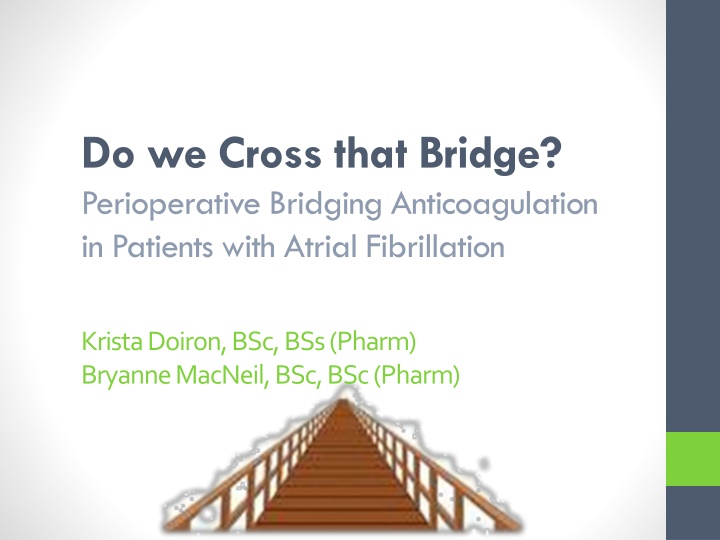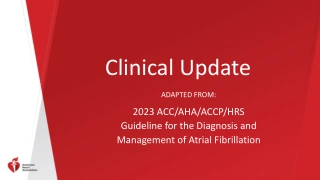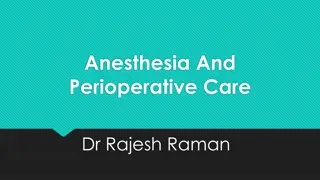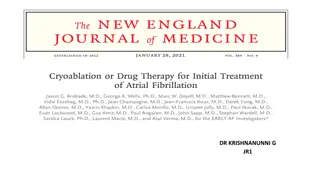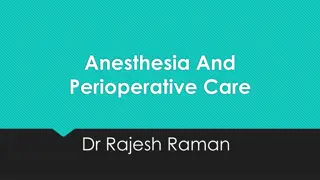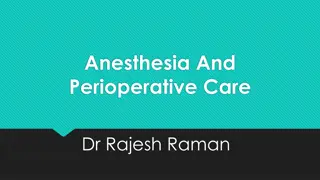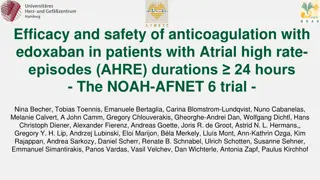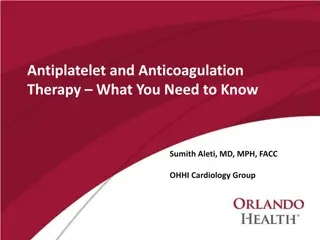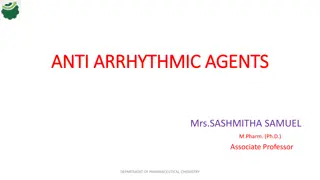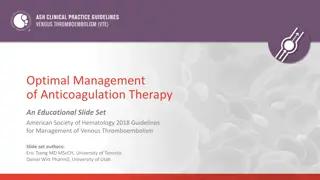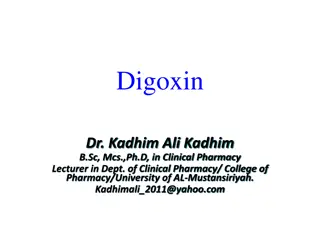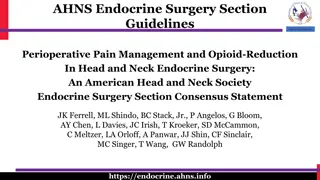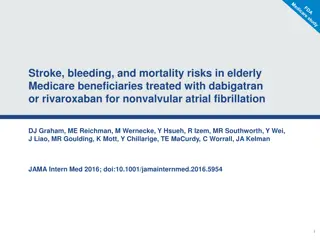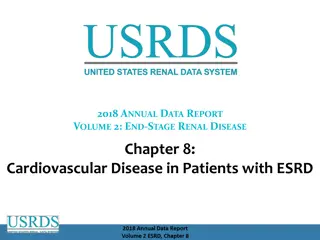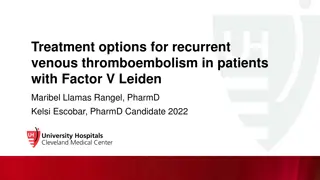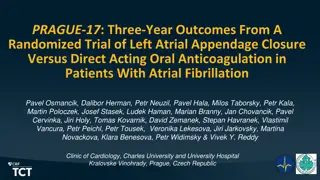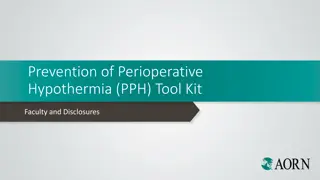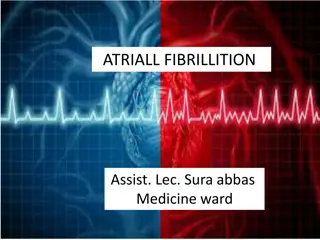Perioperative Anticoagulation in Atrial Fibrillation Patients
A thorough exploration of perioperative bridging anticoagulation in patients with atrial fibrillation, discussing the benefits of anticoagulation, therapeutic options, comparison of literature, and application in moderate-risk patients. The use of warfarin in atrial fibrillation treatment, standard and optional bridging regimens, and the ongoing debate regarding ideal management are highlighted. Valuable insights and considerations for healthcare professionals managing anticoagulation in AF patients are provided.
Uploaded on Sep 28, 2024 | 2 Views
Download Presentation

Please find below an Image/Link to download the presentation.
The content on the website is provided AS IS for your information and personal use only. It may not be sold, licensed, or shared on other websites without obtaining consent from the author.If you encounter any issues during the download, it is possible that the publisher has removed the file from their server.
You are allowed to download the files provided on this website for personal or commercial use, subject to the condition that they are used lawfully. All files are the property of their respective owners.
The content on the website is provided AS IS for your information and personal use only. It may not be sold, licensed, or shared on other websites without obtaining consent from the author.
E N D
Presentation Transcript
Do we Cross that Bridge? Perioperative Bridging Anticoagulation in Patients with Atrial Fibrillation Krista Doiron, BSc, BSs (Pharm) Bryanne MacNeil, BSc, BSc (Pharm)
Learning Objectives Describe the benefit of anticoagulation for the thromboembolic risk associated with atrial fibrillation Discuss therapeutic options for perioperative bridging anticoagulation Compare current literature on perioperative bridging with recent evidence Apply knowledge of perioperative bridging in moderate risk patients to patient case
A Glance at Atrial Fibrillation Non-valvular Atrial Fibrillation (AF) Most common type of arrhythmia and affects approximately 350,000 Canadians 3 to 5 times increased risk of stroke Long-term use of anticoagulant minimizes the risk of subsequent thromboembolic events Provide demonstrated benefit Heart and Stroke Foundation Clinical Interventions in Aging 2013
Warfarin use in AF Warfarin is still commonly used in patients treated for AF Ideal management of periprocedural anticoagulation remains controversial Approximately one in six warfarin-treated patients with AF affected with this clinical scenario each year N Engl J Med. 2015
Perioperative Bridging Regimens Standard Therapy Regimen: Stop warfarin 5 days before an elective procedure to allow its anticoagulant effect to wane Resume after the procedure, when hemostasis is secured 5 to 10 days of treatment required to attain therapeutic levels Thrombosis Canada 2015
Perioperative Bridging Regimens Optional Bridging Therapy Regimen: Begin a low-molecular weight heparin 3 days before the procedure Stop 12-24 hours before surgery to allow anticoagulant effect to wane Resume after the procedure, when hemostasis is secured Continue until warfarin reaches therapeutic levels Thrombosis Canada 2015
Bridging Debate Concerns over periprocedural bleeding complications Significantly higher in patients that use bridging therapy Risk stratification difficult Traditional guidelines vs. recent evidence N Engl J Med. 2015
Patient Case MR is a 76 year old female with history of AF on chronic warfarin therapy Stable on the same warfarin dose for the past 8 months No history of bleeding or thrombotic complications Other comorbidities include: congestive heart failure (EF 30%), hypertension, hypothyroidism, osteoarthritis and type II diabetes Non-smoker and does not drink alcohol
Patient Case Current Medications: Lisinopril 10 mg once daily Carvedilol 25 mg twice daily Furosemide 40 mg once daily Warfarin 2 mg once daily Levothyroxin 50 mcg once daily Alendronate 70mg once weekly on Sundays Metformin 500 mg twice daily
Patient Case MR recently had a fall that fractured the radius in her lower right arm. She requires an open reduction with plate implant and her family doctor is wondering about perioperative anticoagulation recommendations. Do you think she requires bridging therapy?
Risk Stratification CHEST 2012
Dont cross that Bridge! N Engl J Med. 2015
BRIDGE Trial Randomized Double-blind Placebo controlled 1884 patients with AF on warfarin therapy Randomized to receive either bridging therapy or no bridging N Engl J Med. 2015
BRIDGE Trial Relevant Inclusion Criteria 18 years of age or older Chronic atrial fibrillation or flutter Warfarin for 3 months to target INR 2-3 Elective procedure/surgery requiring warfarin interruption 1 CHADS2 risk factor N Engl J Med. 2015
BRIDGE Trial Relevant Exclusion Criteria Mechanical heart valve Stroke, systemic embolism or TIA within 12 weeks Major bleeding within 6 weeks CrCL < 30 mL/min Plt < 100 x 109/L Planned cardiac, intracranial, or intraspinal surgery N Engl J Med. 2015
BRIDGE Trial Study Size 6585 assessed for eligibility 1884 included/randomized Study Population Sex: 73% male Race: 91% Caucasian Age: mean 72 years Weight: 96 kg CHADS2 score: mean 2.3 (~38% with score 3)
BRIDGE Trial RESULTS N Engl J Med. 2015
BRIDGE Trial RESULTS N Engl J Med. 2015
BRIDGE Trial Authors Conclusions: Nonbridging noninferior to bridging for ATE risk, and superior to bridging with regard to bleeding risk Unable to generalize in CHADS2 3 or patients undergoing certain high-risk procedures Benefits may be more pronounced in high-risk procedures that have higher associated bleeding risk? Nonbridging confers additional advantages cost- savings and convenience for patients
BRIDGE Trial Unanswered questions Time spent in therapeutic INR in both groups Characteristics of patients who had a major bleed Adherence to therapy
Cross that Bridge! CHEST 2012
Current Guidelines Risk stratification Low Risk (CHADS2 0-2) = No bridging High Risk (CHADS2 5-6) = Bridging typically recommended Moderate Risk (CHADS 3-4) = ??? Current guidelines consider bridging to be an option for these patients
Cross that Bridge! Arch Intern Med 2004
Douketis et al. 2004 Inclusion criteria: 1. received warfarin therapy, with a target INR of 2-3.5 2. mechanical heart valve, chronic AF or a previous stroke or TIA 3. undergoing an elective surgical or other invasive procedure that requires normalization of INR
Douketis et al. 2004 Primary outcomes: thromboembolism major bleeding death
Douketis et al. 2004 Arch Intern Med 2004
Douketis et al. 2004 =2 =2 =4 =2 Arch Intern Med 2004
Clinician Update Circulation 2012
The Rebuttal 1. Was the trial necessary? Already know that patients with AF have a low risk for stroke during interruption. Was the BRIDGE study necessary? 2. Alternatives to warfarin Will emerging alternatives to warfarin make the BRIDGE study irrelevant?
Rebuttal #1 Was the trial necessary? Studies were retrospective Patients who did not receive bridging may have been in a lower risk group Studies are not a substitute for well-designed clinical trial
Rebuttal # 2 Alternatives to Warfarin? Increased patient expense Reluctance to switch therapies Bridging in these patients deemed not necessary
Pearls In adults with atrial fibrillation and CHADS2 score < 3 undergoing low-risk procedures, forgoing bridging may be a reasonable option to reduce the risk of bleeding without increasing the risk of thromboembolism. Patients with CHADS2 score 3 still need to be addressed on a case by case basis More research required Not all patients addressed by the BRIDGE trial
Patient Case MR recently had a fall that fractured the radius in her lower right arm. She requires an open reduction with plate implant and her family doctor is wondering about perioperative anticoagulation recommendations
Helpful Tools Thrombosis Canada
Learning Objectives Describe the benefit of anticoagulation for the thromboembolic risk associated with atrial fibrillation Discuss therapeutic options for perioperative bridging anticoagulation Compare current literature on perioperative bridging with recent evidence Apply knowledge of perioperative bridging in moderate risk patients to patient case
References 1. Amin A. Oral anticoagulation to reduce risk of stroke in patients with atrial fibrillation: current and future therapies. Clinical Interventions in Aging. 2013;8:75-84. doi:10.2147/CIA.S37818. 2. Douketis JD, Johnson JA, Turpie AG. Low-molecular-weight heparin as bridging anticoagulation during interruption of warfarin: assessment of a standardized periprocedural anticoagulation regimen. Arch Intern Med. 2004 Jun 28;164(12):1319-26. 3. Douketis JD, Spyropoulos AC, Kaatz S, Becker RC, Caprini JA, Dunn AS, Garcia DA, Jacobson A, Jaffer AK, Kong DF, Schulman S, Turpie AG, Hasselblad V, Ortel TL; BRIDGE Investigators. Perioperative Bridging Anticoagulation in Patients with Atrial Fibrillation. N Engl J Med. 2015 Aug 27;373(9):823-33. 4. Eikelboom JW, Hirsh J, Spencer FA, Baglin TP, Weitz JI. Antiplatelet drugs: Antithrombotic Therapy and Prevention of Thrombosis, 9th ed: American College of Chest Physicians Evidence-Based Clinical Practice Guidelines. Chest. 2012 Feb;141(2 Suppl):e89S-119S. doi: 10.1378/chest.11-2293. Review. 5. Heart and Stroke Foundation. Atrial fibrillation - Be pulse aware. Accessed Oct 2015. http://www.heartandstroke.com/ 6. Piccini JP, Holmes DN, Ollis DM, Fraulo ES, Thomas L, et al. (2011) Patterns of Atrial Fibrillation and Treatment Strategies Vary According to Provider Specialty Across Community Practice Settings: Findings From the ORBIT-AF Registry. Circulation 124: A16415. 7. Questions about the Rationale and Justification of the Bridge Study. (2015). 8. Thrombosis Canada. Peri-operative Management Of Patients Who Are Receiving A New Oral Anticoagulant (Dabigatran, Rivaroxaban, Apixaban). Accessed November 2015. http:www.thrombosiscanada.ca 9. Thrombosis Canada. Perioperative Coagulation Management Algorithm. Accessed October 2015. http:www.thrombosiscanada.ca 10. Wysokinski WE, McBane RD 2nd. Periprocedural bridging management of anticoagulation. Circulation. 2012 Jul 24;126(4):486-90.
